I’m honored to have been a witness to the transformation of an ordinary, high-traffic area of an Austin schoolyard lawn to a most outstanding wildlife habitat, and I just have to show it off.
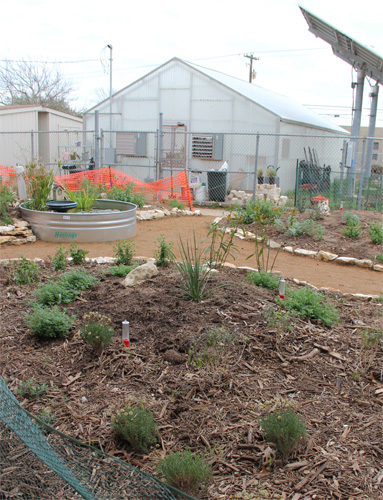
The Murchison habitat, with the school’s greenhouse
and solar panel in the background. Temporary fencing
helps discourage deer while young plants are growing.
The habitat team at Murchison Middle School, led by science teacher Bret Korba, had the opportunity to participate in a small grant program being offered by National Wildlife Federation to several Austin-area schools. In order to receive the grant, each habitat team had to fulfill multiple requirements, including providing a detailed habitat design and implementation plan.

All the basic elements of a habitat are provided:
food, water, cover, and places to raise young.
The Murchison team hit the ground running, starting right away to make their project a reality. They selected a site near their school’s existing greenhouse and vegetable garden, they studied student traffic and water run-off across the site, and they contacted the district grounds department for project site approval. Throughout the process, they kept their administration and PTA informed and involved, soliciting assistance when needed.
Here’s the area before any work was done:
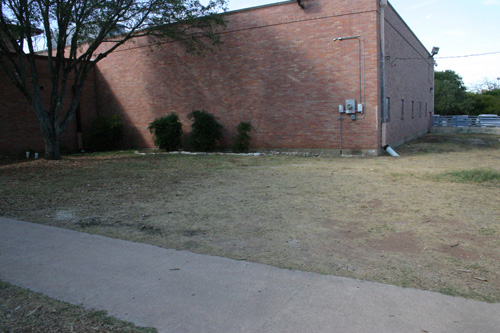
A blank slate, if ever I saw one!
Dedicated parent volunteer Narda Fisher created a beautiful design and wildlife-friendly plant list, and the team moved ahead with planning workdays, ordering materials, and gathering volunteers. The goal, aside from creating a functional outdoor learning space, was to have a successful wildlife habitat filled with almost all native Texas plants.
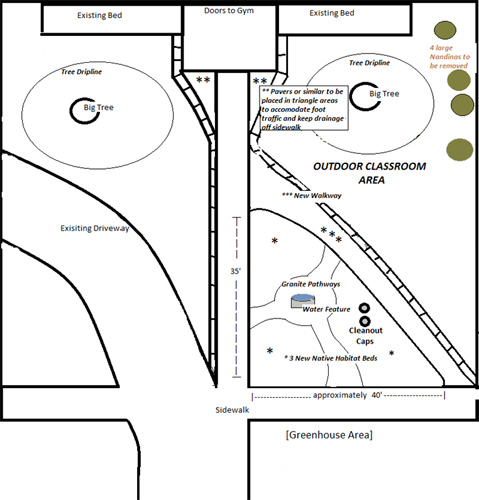
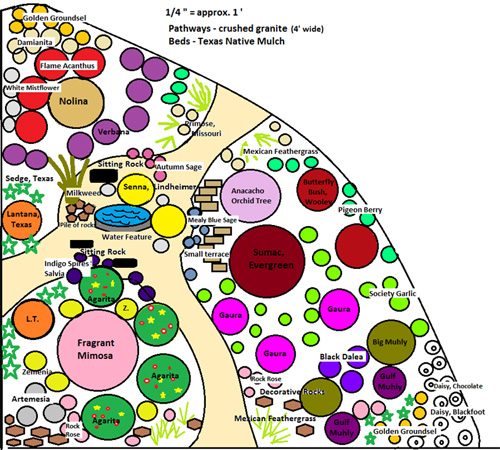
What I love about this design is that it shows how easily a colorful visual of a habitat plan can be created using just a simple program like Paint. The advantage to making a colorful representation of a school’s future garden is that you can share it with students, parents, and the community to encourage their enthusiasm and volunteerism, and you can also show it to local businesses and organizations to help solicit donations of materials or funds.
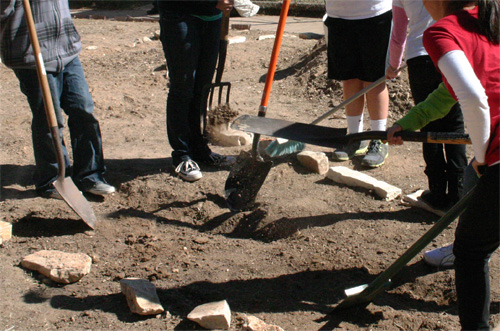 Right away, students became a part of preparing the beds, digging out grass, moving rocks, and marking pathways. Some of the students were members of the school’s Green Team, a large afterschool club that takes care of Murchison’s vegetable garden and sometimes other areas of the school grounds. Take a look at the thriving vegetable garden the students have been working on:
Right away, students became a part of preparing the beds, digging out grass, moving rocks, and marking pathways. Some of the students were members of the school’s Green Team, a large afterschool club that takes care of Murchison’s vegetable garden and sometimes other areas of the school grounds. Take a look at the thriving vegetable garden the students have been working on:
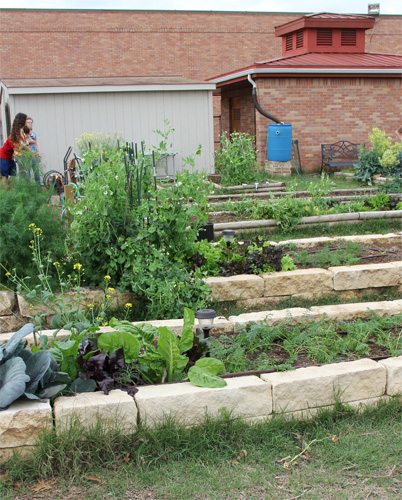
My stomach still growls with hunger as I remember the delicious smell of eggs and fresh herbs that teacher and habitat team member Benjamin Newton was cooking in the greenhouse for the Green Team students one day when I stopped by with some native seeds — yum. FYI, this student club meets twice a week, and their dedication and active involvement really shows.
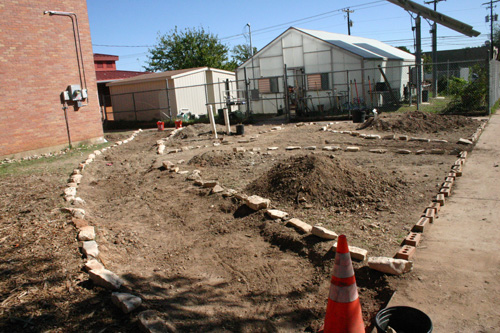
View of early progress
During school, several Murchison teachers brought their classes out to help with the garden. Additionally, a couple of volunteer Saturday workdays brought rapid progress to the final bed preparation and planting.
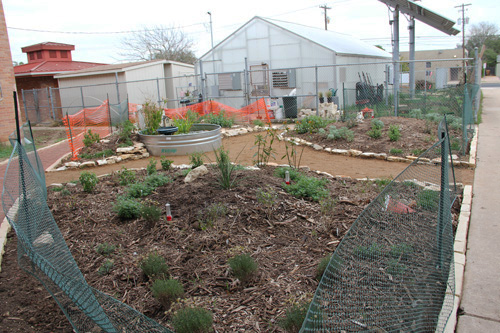
Same view, after habitat completion
In order to provide well-drained soil for the native plants, volunteers and students utilized some of the soil dug out from pathways and combined it with supplemental soil, the excellent Thunder Dirt from GeoGrowers.
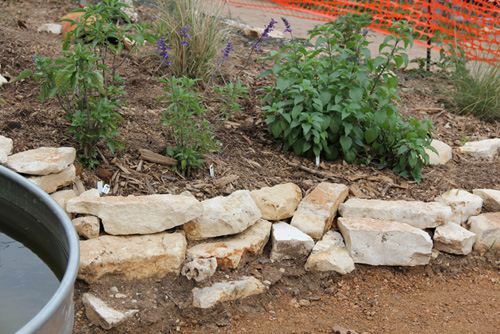
A simple unmortared retaining well keeps the mounded soil in place while allowing lizards and other small wildlife to seek shelter. The rocks were collected from a school neighbor who was having construction done on her house. The single-shred mulch used to protect the plants and suppress weeds was donated by a school parent.
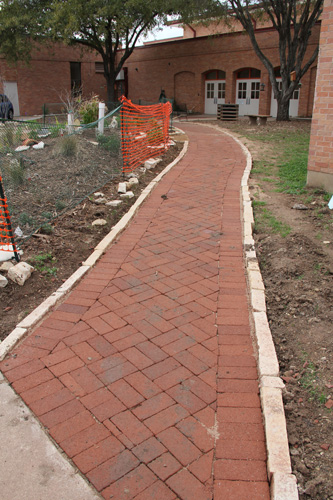 While the team sought out donations where they could, part of their grant funds went to purchasing plants, soil, decomposed granite, bricks, and the stock tank. The PTA assisted by paying for someone to level and lay down the brick path that guides most of the daily student traffic between their classes. For the interior habitat pathways, the habitat team chose decomposed granite.
While the team sought out donations where they could, part of their grant funds went to purchasing plants, soil, decomposed granite, bricks, and the stock tank. The PTA assisted by paying for someone to level and lay down the brick path that guides most of the daily student traffic between their classes. For the interior habitat pathways, the habitat team chose decomposed granite.
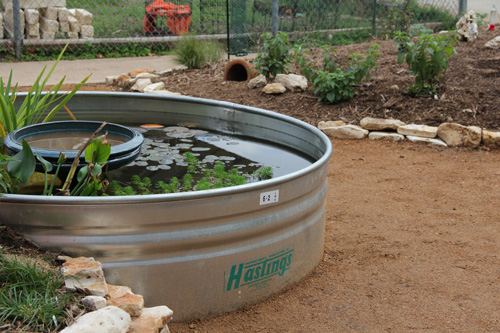
Little touches really enhance the garden. A tall birdbath within the pond makes it easier for birds to drink, and rocks within the pond offer an escape route for any animal that might accidentally slip in. Ongoing residents of the pond include Gambusia, or mosquito fish.
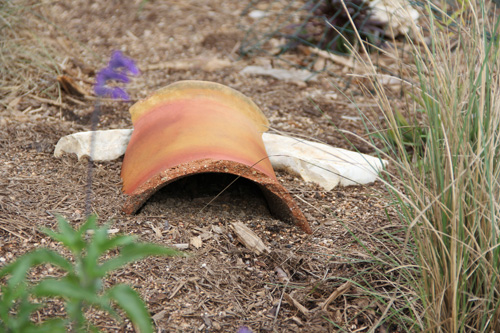
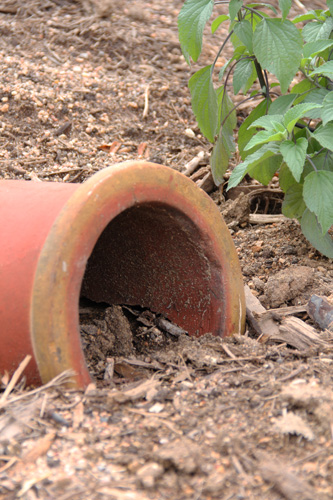 Broken pots create perfect little toad shelters, and there’s even a solar-panel water wheel in the pond. Nearby, birdfeeders and birdhouses adorn large trees.
Broken pots create perfect little toad shelters, and there’s even a solar-panel water wheel in the pond. Nearby, birdfeeders and birdhouses adorn large trees.
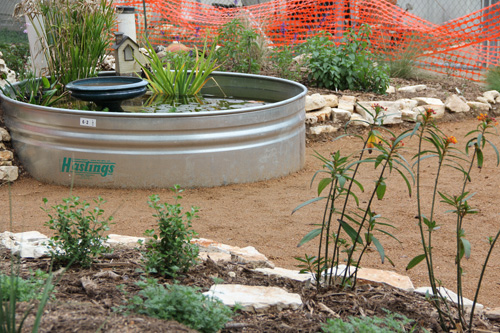 Already, Murchison’s habitat team and Green Team are prepping new habitat beds and an area for a large rain tank. With such a variety of elements, Murchison teachers will be able to take their classes outdoors to utilize the new habitat for countless curriculum applications.
Already, Murchison’s habitat team and Green Team are prepping new habitat beds and an area for a large rain tank. With such a variety of elements, Murchison teachers will be able to take their classes outdoors to utilize the new habitat for countless curriculum applications.
Schoolyard habitats like this are so critical for our children who, in a world of technological dependency and urban concrete, often do not have much direct exposure to nature. Studies have shown that outdoor time helps reduce childhood obesity and helps increase emotional health, academic success, and creativity. Their health and Earth’s future are dependent on kids spending time outdoors, connecting with nature.
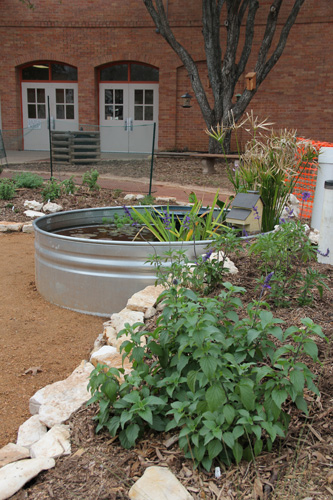 It takes a team to create a new schoolyard habitat, whether it be small or large. The team can be made of teachers, students, parents, school staff, and/or community members, and working together, they can change the world, so to speak. But for a schoolyard habitat to be the most successful, it’s also imperative that the school’s administration offer positive support, that many teachers get involved, and that the school district help open doors to allow change and outdoor learning time on school grounds.
It takes a team to create a new schoolyard habitat, whether it be small or large. The team can be made of teachers, students, parents, school staff, and/or community members, and working together, they can change the world, so to speak. But for a schoolyard habitat to be the most successful, it’s also imperative that the school’s administration offer positive support, that many teachers get involved, and that the school district help open doors to allow change and outdoor learning time on school grounds.
But every school’s situation is different, and sometimes volunteers have a big role in helping a project like this succeed. If you have a chance to be a part of helping design, build, or maintain a school habitat or vegetable garden, I do hope you’ll jump at the chance and help kids have an outdoor space they can learn and benefit from.
I commend the Murchison habitat team and administration for sharing their love of nature with their students and getting them outdoors, and for creating a beautiful habitat that will help provide for wildlife for years to come. Murchison Middle School, congratulations!
If you are interested in creating an outdoor learning space at your local school, visit NWF’s webpages on schoolyard habitats for excellent resources such as how-to guides, lesson plans, and more.
This is wonderful!
Most definitely — and they just keep going and going, too!
What a FANTASTIC job those kids have done with that blank slate. What a joyful thing to turn a piece of dirt into something so gorgeous and Earth friendly.
Great work everyone!
Wouldn’t we all be so lucky to get to play in the dirt as part of class — I know I’d love it!
What a fabulous accomplishment! The garden design and execution look great. Any lizard would be proud to call that rock work “home”. Kudos to all involved.
This is fantastic! Lucky kids & teachers! Wish I had while attending school.
I think a native school garden is a wonderful thing. I was just listening to a show about getting kids outdoors and they cited a study that showed ADHD kids who spent as little as 20 minutes in a park did as well on tests as kids that were on Ritalin.
And this kids so much more to talk and write about.
I’m so glad you chose to be involved with this garden and share it with us.
Isn’t it great? It’s so pleasant to walk through. I’d be happy if I were a lizard there.
Me, too — I moved a lot as a kid, and none of my schools had outdoor nature areas. On the other hand, we did spend a fair amount of time outdoors overall, and I even got to take a school-sponsored week long camping trip. And then again, there wasn’t much in the way of electronic distractions.
A great book to read is “Last Child in the Woods,” Marilyn, if you have a chance (author is Richard Louv). The book talks about nature-deficit disorder and why it’s vital that we help get children outdoors. It’s excellent.
Meredith,
I am so impressed with the work you have done to show off our work here at Murchison. We have had so much fun putting all this together, and it truly was a team effort. Narda was awesome with the design and overseeing. Ben Newton and Eric Mathison brought their students out often to dig and clean. We did not worry much about making mistakes, because after all, it’s just dirt, plants, and design, and if something didn’t look right we could just undo it and move it. Thank you so much for your help with all this. We are continuing with our plans to transform the rest of this area. We are always out here on Tuesdays and Fridays if anybody wants to come visit.
Thanks, Bret. That’s the wonderful thing about gardening — there’s flexibility whenever you want to change something. I’m looking forward to the newest habitat features and the big celebration!
Congratulations on the accomplishment. School gardens (of all sorts) can be fabulous learning experiences. It’s always a good thing to add native plants to an area, as well.
Anyone who has worked with school gardens of any type knows it can be an uphill battle to get from planning to installation to ongoing involvement. The kids, parents, and teachers at Murchison are really amazing and an inspiration to others with what they’ve accomplished. Special thanks to you, Meredith, for providing that special spark that’s unique to you. Our entire community benefits from your combined efforts here.
Absolutely superb!!! As a retired teacher I am jealous of this wonderful effort with marvelous success! 😉 I hope new and current teachers will take this idea and race forward. It’s obvious that it is good for everyone (and every animal and plant)! Yea Murchison Marvels!!!
Oh wow! Looks great, kids! way to go! The birds, toads, lizards, and other animals that will call your garden home are going to be so lucky.
(also my captcha is water)
Tina, while there are many schools working on gardens of their own, there are many more that desperately need them. But someday we’ll reach them!
Vicki, I can only claim to have offered advice where I could — the school team, students, and volunteers really did it all! Cheers to NWF for making it all possible.
Cheers coming from a retired teacher I’m sure will make the Murchison team all the more proud of what they have done — thank you!
Perfect, Katina — how did captcha know? 😀
What a beautiful garden for the school, where once there was nothing but flattened grass and dirt! It’s so great to see the kids getting involved in the project from start to finish too. Way to go, Murchison!
For anyone interested, Gullett Elementary made a similar garden a few years ago, and I wrote a blog post about that project. It really does take a village to get these gardens growing, and the Austin business, parent, teacher, student, and neighborhood communities are willing to step up and help when asked. http://www.penick.net/digging/?p=348
Thanks for sharing your Gullett post, Pam — that school garden is amazing and ever-growing! It, too, is such an inspiration.
Wow! That is truly spectacular!
Really enjoyed reading about this project. Awesome pictures too.
That is a very beautiful design as well. Quite inspiring.
Thank you so much and keep up with your important work!
This is marvelous! How wonderful, and what awesome kids!
Thanks, Reed — it’s been a spectacular project, start to finish.
They are indeed awesome, Ursula!